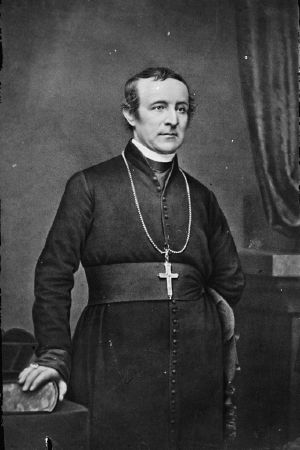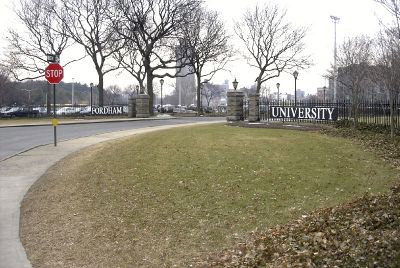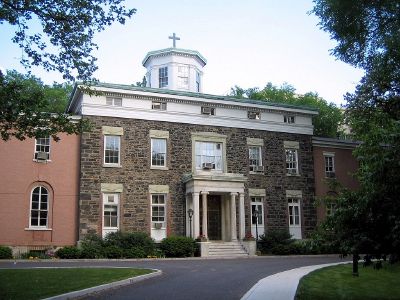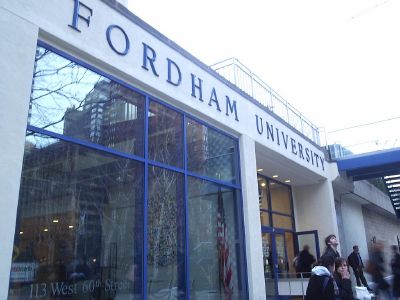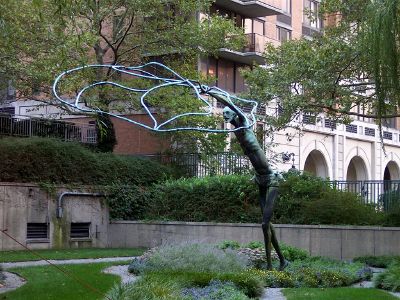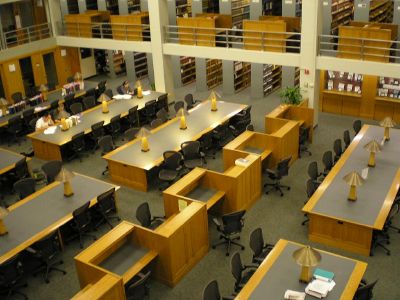Fordham University
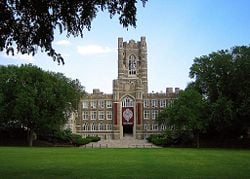 Latin: Universitas Fordhamensis | |
| Motto | Latin: Sapientia et Doctrina (Wisdom and Learning) |
|---|---|
| Established | 1841 (as St. John's College) |
| Type | Private, Independent, Catholic, Jesuit |
| Location | Bronx, Manhattan, and West Harrison, New York United States |
| Website | www.fordham.edu |
Fordham University is a private university in the United States, with three campuses located in and around New York City. Founded by the Roman Catholic Diocese of New York in 1841 as St. John's College, it was placed in the care of the Society of Jesus (Jesuits) shortly thereafter. Today Fordham is an independent university in the Jesuit tradition. Governed by a Board of Trustees the majority of whom are lay members, Fordham retains its time-honored Jesuit traditions. These include an emphasis on care for the individual student and their potential; standards of excellence and rigor in academic study; adherence to ethical values; and a commitment to living life beyond self by contributing time and talent in service to the community.
With a long tradition of excellence in academics and theology, Fordham University has over the years broadened into many disciplines of the liberal arts, as well as outreach to the global community. Over the years, Fordham has attracted notable faculty members and has produced many graduates who have achieved great success both in their individual lives and in service to the wider community.
Mission and reputation
Fordham University "is committed to the discovery of Wisdom and the transmission of Learning, through research and through undergraduate, graduate and professional education of the highest quality."[1] While the school is no longer subject to strictly religious administration, it nonetheless values and incorporates its religious history and tradition, particularly in regards to the paradigm of Jesuit educational philosophy. The University promotes a Jesuit principle known as cura personalis, which fosters a faculty and administration respect for the individual student and their uniqueness, and the Jesuit principle magis which intends to inspire service and strive for excellence in all aspects of life, even beyond the academic.[2]
Fordham University has a long standing reputation of excellence, both for secular and religious studies. Fordham University attracts students from around the world.[3] Fordham's graduate schools have often been singled out for their excellence.
History
Fordham University was originally founded in 1841 as St. John's College by the Coadjutor Bishop (later Archbishop) of the Diocese of New York, the Most Reverend John Joseph Hughes. The College was the first Catholic institution of higher education in the northeastern United States.[4] Bishop Hughes purchased most of Rose Hill Manor and Estate in Fordham, the Bronx, then part of Westchester County, at $40,000 for the purpose of establishing the school.[4] St. John's College opened with only six students on June 24, 1841, with the Reverend John McCloskey as its president. Most of the original faculty were secular priests and lay instructors. The College was paired with a seminary, St. Joseph's, which had been founded in 1839 and was in the separate charge of Italian Lazarists (also known as "Vincentians"). In 1861, St. John's College ended its connection to the seminary when St. Joseph's closed.
In 1846, St. John's College received its charter from the New York state legislature, and Bishop Hughes convinced a group of Jesuits from Kentucky to staff the new school. With the addition in 1905 of a law school and a (now defunct) medical school, the name was changed to Fordham University in 1907.[5]
Throughout the early twentieth century, the school continued to expand. In 1912, the university opened a College of Pharmacy, which offered a three-year program in pharmacy and did not require its students to obtain bachelor's degrees until the late 1930s. The College had a mainly Jewish student body, and in recognition of that, students were exempt from the then-required course in Catholic theology. The College's longtime dean, Jacob Diner, was also Jewish. The College of Pharmacy closed because of declining enrollment in 1972.
In 1961, Fordham Law School opened at the new Lincoln Center campus—the first building to open in the Lincoln Square Renewal Project.In 1969, the colleges at 302 Broadway were moved to the new Lowenstein Building on the Lincoln Center campus, and other colleges soon followed.[6]
The middle to late twentieth century proved to be a turning point in the school's history. In 1969 the board of trustees was reorganized to include a majority of non-clergy members, and officially made the University an independent institution.[4] Fordham College at Rose Hill became coeducational in 1974, as a result of the merger with Thomas More College (the University’s coordinate college for women opened in 1964).[6] Fordham maintained its prestige for both secular and religious studies throughout the later half of the twentieth century.
With the twenty-first century, the university once again looked at expanding and restructuring. In August 2005, the University announced a multi-year, $1 billion proposed master plan to add 1,500,000 square feet (140,000 m²) of academic, student activities, and dormitory space to the Lincoln Center campus. The development of the campus was set to begin with the expansion of Quinn Library and the construction of a new Law School building, a new student center, a dormitory, and additional parking. Future phases of the development plan included the construction of new space for Fordham College of Liberal Studies, Fordham College at Lincoln Center, the Graduate School of Business, the Graduate School of Social Service, and the Graduate School of Education.[7]
Fordham, like many universities, has also started to reach out to the global community. In April 2008, Fordham entered into an affiliation with Heythrop College, the Jesuit specialist Philosophy and Theology College of the University of London, located near Kensington Square, in central London. The University of London Consortium of Colleges consists of such institutions as King's College London, University College London, and the London School of Economics and Political Science. After a nearly eight-year association with Heythrop College in one of London’s more cultivated neighborhoods, Fordham’s London Center moved to a newly renovated building in Clerkenwell, a much more active and student-friendly neighborhood. Stephen Freedman, provost of the university, said that the move showed that "Fordham reasserts its commitment to international education, and to the University’s presence in London.”[8]
Facilities
Fordham University has three main campuses located in New York: Rose Hill, Lincoln Center, and Westchester.
Rose Hill
The Rose Hill campus, established in 1841, is home to the undergraduate Fordham College at Rose Hill, the College of Business Administration, and a portion of the Fordham College of Liberal Studies as well as the Graduate School of Arts and Sciences, and the Graduate School of Religion and Religious Education. Located on 85 acres (340,000 m²) in the north Bronx, it is among the largest "open space campuses" in New York City.[6] The campus is bordered by the New York Botanical Garden, the Bronx Zoo, and "Little Italy of the Bronx" on Arthur Avenue. Rose Hill is also home to the University Church, which was built in 1845 as a seminary chapel and parish church for surrounding farms. The gothic-style church is an official New York City landmark and contains the original altar from Old St. Patrick's Cathedral along with stained glass windows first intended as a gift by Louis-Philippe of France for the cathedral.[4]
Lincoln Center
The Lincoln Center campus, established in 1961, is home to the undergraduate Fordham College at Lincoln Center and a portion of Fordham College of Liberal Studies, as well as the School of Law, the Graduate School of Business Administration, the Graduate School of Education, and the Graduate School of Social Service. The eight-acre campus occupies the area from West 60th Street to West 62nd Street between Columbus and Amsterdam Avenues, in the cultural heart of Manhattan. Across the street is one of the world's great cultural centers, Lincoln Center for the Performing Arts; nearby are Central Park, Broadway, and Columbus Circle.
Westchester
In 2008, the University moved Fordham College of Liberal Studies (Westchester Division), graduate schools of Business Administration, Education, Social Service, and Religion and Religious Education, from the Marymount campus to 400 Westchester Avenue, in West Harrison, New York.[9]
The new campus includes a three-story, 62,500-square-foot (5,810 m²) building on 32 landscaped acres with a stream and pond. The facilities include 26 newly designed classrooms featuring technological amenities such as "smart boards," teleconferencing capabilities, and newly installed seating and learning areas.
In addition, faculty offices and administrative support space, a library resource center, a food service facility, and meeting areas both indoor and outdoor for student sessions are available. Over $8 million was spent in renovation to provide the University with green building technology, including the design of academic facilities surrounding a large central courtyard.[10]
Libraries and other facilities
The Fordham University libraries own over 2 million volumes, subscribe to over 15,500 periodicals and 19,000 electronic journals, and are a depository for United States Government documents.[6] The William D. Walsh Family Library is at the Rose Hill campus; the Gerald M. Quinn Library at the Lincoln Center campus; and the Leo T. Kissam Memorial Law Library serves the Law School.
The McGinley Student Center is located on Rose Hill, and is headquarters for all all student activities as well as where many of the university's conferences are held. The Rose Hill University Gym is where many of the university's sports team play and practice, as well as housing equipment and space for recreational exercises and other activities. The spiritual center of the main campus is the University Church, which was built in 1845 and became an official landmark of New York City in the late twentieth century[11] Fordham has other spiritual facilities, such as the Philip H. McGrath House of Prayer, located in Goshen, NY, which is used exclusively for Fordham's Retreat Ministries. The McGrath House is situated in a rural, residential area about seventy miles northwest of Fordham's Rose Hill campus. The McGrath House has facilities for a large group of students and retreat coordinators to stay overnight while participating in a Fordham Retreat. Fordham Campus Ministry regularly hosts non-compulsory retreats at the McGrath House, including Emmaus, Kairos, Charis, Global Outreach Retreats, and other specialized retreats.
In December 2007, the University established the Fordham Museum of Greek, Etruscan and Roman Art at the William D. Walsh Family Library on the Rose Hill campus. The museum contains more than 200 relics from classical antiquity, ranging from Greek terra cotta vases to Roman marble heads to Etruscan urns. The museum was a gift from William D. Walsh, a 1951 graduate and founding chairman of Sequoia Associates. It is the largest collection of its kind in the New York metropolitan area.[12]
Programs
Fordham has almost 100 different academic programs. Many of the undergrad degrees are aspects of the usual Liberal Arts colleges, such as Literature, Anthropology, Business, Economics, Chemistry, Biology, and History. There are also several Divinity and Theological undergraduate programs that are sometimes connected to other disciplines.
The differing graduate level colleges offer many different programs, such as Law, Theology, Business, Education, Social Work, and programs in the liberal arts and sciences.
Fordham offer two international programs:
The Beijing International MBA Program (BiMBA) is a joint venture between a consortium of Jesuit Colleges and Universities in the United States and Peking University and is managed by Fordham University and the China Center for Economic Research (CCER).[13] BiMBA was founded in 1998 and is located on the campus of Peking University in Beijing, People's Republic of China. BiMBA enrolls over 400 students a year in traditional part-time and full-time MBA programs, and in Executive MBA (EMBA) programs.
The other international program is the London Drama Academy (LDA) at Fordham's Bloomsbury-area London Center, which offers classes on British acting, using a primarily practical approach. The Academy was founded in the 1970s by Marymount College and a group of tutors from the Royal Academy of Dramatic Art (RADA). It offers semester- and year-long sessions, with classes taught by working RADA-trained theater professionals.
Colleges, schools, and institutes
Fordham University comprises four undergraduate colleges and six graduate schools on three campuses.
Undergraduate colleges
- Fordham College at Rose Hill
- College of Business Administration
- Fordham College of Liberal Studies
- Fordham College at Lincoln Center
Graduate schools
- Fordham University School of Law
- Graduate School of Arts and Sciences
- Graduate School of Education
- Graduate School of Social Service
- Graduate School of Business
- Graduate School of Religion and Religious Education
Institutes
Fordham also houses several institutes and centers for various studies:
- J. Calder Center Biological Field Station
- and Ann Curran Center for American Catholic Studies
- of Irish Studies
- for Medieval Studies
- American and Latino Studies Institute
- for International Policy Studies
- Twaalfhoven Center for Entrepreneurship
- for Communications
- for Management Studies
- University Pricing Center
- J. Petrilli Center for Research in International Finance
- Finance Institute
- for Learning in Unsupervised Environments
- Resiliency Institute
- Institute for Religion and Poverty
- for Women and Girls
- Center for Family and Child Advocacy
- Center on Aging
- for Ethics Education
- Hughes Institute on Religion and Culture
- Center on Religion and Culture
- of International Humanitarian Affairs
- Moore Trial Advocacy Center
- on European Union Law
- on Law and Information Policy (CLIP)
- Center for Social Justice and Dispute Resolution
- Center for Corporate, Securities and Financial Law
- on Religion, Law and Lawyers' Work
- Center for International Law and Justice
- Stein Center for Law and Ethics
Student life
Fordham students have numerous activities and interests beyond academics. The University supports 22 men's and women's varsity teams and a number of club teams, plus a significant intramural sports program. The Fordham Rams are members of NCAA Division I and compete in the Atlantic 10 Conference in all sports except football. In football, the Rams play in the Patriot League of NCAA Division I Football Championship Subdivision. Fordham athletics gained early fame for college football in the beginning of the twentieth century, particularly with the success of the famous "Seven Blocks of Granite." In addition, the University launched the careers of dozens of professional baseball players, including a Hall of Fame inductee, Frankie Frisch, known by the further-alliterative nickname, "The Fordham Flash."[14] The Sixth Man Club, supports the Fordham University Men's and Women's basketball programs. The club was founded in the early 1990s by a group of Rose Hill College seniors. The Sixth Man cheers on and roots for the Rams from the Section 8 bleachers in the Rose Hill Gym.[15]
Fordham has several student publications, including the literary/creative magazines Red Rover and The Ampersand, and news publications The CBA Business Journal, The Fordham Ram, and The Fordham Observer. Fordham also offers several student run/oriented media outlets, such as WFUV, 90.7 FM the University's 50,000-watt radio station, with studios located in Keating Hall on the Rose Hill campus and the transmitter located atop a building owned by Montefiore Medical Center, and the Fordham Nightly News (FNN), Fordham University's evening news program since 2004, created and produced by students.[6]
Fordham has several performing clubs and organizations, including the Fordham University Choir, whose repertoire includes both sacred and secular music, the Fordham University Women's Choir, the all-male a cappella group the Fordham Ramblers, and the all-female a cappella group the Fordham Satin Dolls. Fordham has several acting groups, including the Fordham University Theatre Company, the theatrical troupes Mimes & Mummers, and the Fordham Experimental Theatre, and the Expressions Dance Alliance.
Fordham University also has an excellent Debate Society. In 1982, the American Parliamentary Debate Association (APDA), Inc. was founded at Fordham, during a tournament called the "Fordham Fandango." FDS is still very active on APDA, and regularly places among the top teams in the country. The team competes weekly on APDA, but also occasionally attends international tournaments, ranking well in the World Universities Debating Championship standings. The Gannon Speech and Debate is based at the Lincoln Center Campus, and engages students in forensics training so that they may compete intercollegiately. The club is named for the Rev. Robert I. Gannon, S.J., President of Fordham from 1936–1949, considered to have been a popular and effective speaker. Alumni of the club have been successful in earning fellowships and awards.
Global Outreach! (commonly known as GO!), is a student led, university sponsored organization dedicated to educating students about issues of social justice and individual responsibility through service trips to global and domestic locations. Separate programs on each campus currently sponsor 27 annual trips ranging from Thailand to East New York, and dealing with such diverse issues as public health, affordable housing, migrant labor, and disaster relief.[6]
Traditions
Fordham has many traditions. The university's mascot, a ram evolved from a rowdy cheer that Fordham fans sang during an 1893 football game against the United States Military Academy at West Point. The students began cheering "One-damn, two-damn, three-damn…Fordham!" The song was an instant hit, but "damn" was later changed to "Ram" to conform to the university's image.[4]
The Victory Bell, which is mounted outside the Rose Hill Gym, was a gift to Fordham University by Admiral Chester W. Nimitz from a Japanese naval vessel sunk during World War II. It was blessed by Cardinal Spellman, and was first rung by the President of the United States, Harry S. Truman in 1946 for the Charter Centenary of the University. Tradition now holds that it be rung by each Fordham senior player after victorious home football games and its ringing also marks the start of the commencement ceremonies each May.[6]
The University annually presents a concert of Lessons and Carols during the Christmas holiday season. The ensemble university choir presents one evening concert at the large and dramatic Church of Saint Paul the Apostle adjacent to the Lincoln Center Campus, and one afternoon concert at the more humble and intimate University Church at the Rose Hill Campus, each year.[16]
Fordham College at Rose Hill annually stages an Encaenia on an evening near the conclusion of the academic year. Faculty, administrators, and students process in academic regalia to a ceremony where candidates for degrees at the current year's commencement are presented awards and honors. The ceremony includes a sentimental speech by the college's valedictorian, as well as the traditionally more humorous yet equally endearing speech by the honorary "Lord" or "Lady of the Manor" selected for the evening.[17]
Notable people
Alumni
Among the notable people who have attended Fordham are:
- Alan Alda, six-time Emmy Award and six-time Golden Globe Award-winning actor.
- William Casey, former United States Director of Central Intelligence.
- Mary Higgins Clark, best-selling suspense novelist.
- Geraldine Ferraro, former Representative to the United States Congress, the first woman Vice Presidential candidate by a major political party in the United States.
- Frankie Frisch, known as the "Fordham Flash," Baseball Hall of Famer.
- General John "Jack" Keane, retired four-star General and former Vice Chief of Staff of the United States Army.
- Bob Keeshan, television's multiple award-winning Captain Kangaroo.
- G. Gordon Liddy, lawyer, political operative for President Richard Nixon, leader of the White House Plumbers, political pundit, and radio show host.
- Vince Lombardi, football coaching legend.
- Charles Osgood, three-time Emmy Award and two-time Peabody Award-winning journalist and Radio Hall of Fame inductee.
- Eugene Shvidler, Russian-American billionaire and international oil tycoon.
- Denzel Washington, two-time Academy Award and two-time Golden Globe Award-winning actor.
Faculty
- Joseph Abboud, fashion designer.
- Bruce Andrews, poet and theorist on state and global capitalism.
- Hilaire Belloc, writer.
- Daniel Berrigan, S.J., poet-in-residence and world-renowned peace activist.
- Mary Bly, writer.
- Joseph Campbell, poet, Irish studies scholar, Irish republican and POW.
- W. Norris Clarke, S.J., philosopher and noted authority on St. Thomas Aquinas.
- Avery Cardinal Dulles, S.J., noted theologian, Cardinal of the Roman Catholic Church.
- Brian Davies, OP, noted philosopher of religion and Aquinas scholar.
- Patrick Heelan, S.J. noted philosopher of science.
- Victor Francis Hess, Nobel Laureate for physics.
- Dietrich von Hildebrand, theologian.
- William T. Hogan, S.J., economist and noted authority on the steel industry.
- J. Quentin Lauer, S.J., philosopher and noted authority on Georg Wilhelm Friedrich Hegel
- Paul Levinson, author of The Plot To Save Socrates and winner of the 1999 Locus Award for Best First Novel.
- James Marsh, radical philosopher and noted authority on Marx
- Mark Massa, S.J., authority on American Catholicism.
- Matthew Maguire, two-time OBIE Award-winning actor, director, and playwright.
- Marshall McLuhan, communications theorist and coiner of the phrase, "the medium is the message."
- Frederick Marotto, mathematician, author of the "Marotto Theorem" dealing with Chaos theory.
- William O'Malley, S.J., actor in the film The Exorcist, for which he was also a technical adviser; author of numerous books.
- Margaret Mead, noted anthropologist.
- Diana Villiers Negroponte, professor of history and law; wife of U.S. Director of National Intelligence John Negroponte.
- Lawrence J. Sacharow, OBIE Award-winning director.
- Asif Siddiqi, historian specializing in the Cold War Era space race between the United States and the Soviet Union. He is a leading authority and scholar on the Soviet Space Program.
- Daniel Soyer, historian, author, and authority on Jewish immigration into New York City.
Notes
- ↑ Mission Statement Fordham University. Retrieved February 5, 2023.
- ↑ About Fordham Fordham University. Retrieved February 5, 2023.
- ↑ International Students Fordham University. Retrieved February 5, 2023.
- ↑ 4.0 4.1 4.2 4.3 4.4 Raymond A. Schroth, Fordham: A History and Memoir (Fordham University Press, 2008, ISBN 0823229777).
- ↑ Fordham’s History Fordham University. Retrieved February 5, 2023.
- ↑ 6.0 6.1 6.2 6.3 6.4 6.5 6.6 Emily Intravia, Fordham University: Off the Record (College Prowler, 2006, ISBN 142740061X).
- ↑ Fordham University, Fordham Unveils Lincoln Center Master Plan. Retrieved January 11, 2009.
- ↑ Tom Stoelker, Fordham’s New London Centre Is Central to University’s International Strategy Retrieved February 5, 2023.
- ↑ About Our Westchester Campus Fordham University. Retrieved February 5, 2023.
- ↑ Campus and Facilities at Westchester Campus Fordham University. Retrieved February 5, 2023.
- ↑ The University Church Brochure Fordham University. Retrieved February 5, 2023.
- ↑ Robin Pogrebin, Fordham Opens Its Gift: An Antiquities Museum, The New York Times, December 6, 2007. Retrieved February 5, 2023.
- ↑ Programmes: Master BiMBA. Retrieved February 5, 2023.
- ↑ Frankie Frisch National Baseball Hall of Fame. Retrieved February 5, 2023.
- ↑ The Sixth Man Club Retrieved February 5, 2023.
- ↑ Fordham University, Fordham University Choir Fordham News. Retrieved February 5, 2023.
- ↑ Encaenia Undergraduate Bulletin. Retrieved February 5, 2023.
ReferencesISBN links support NWE through referral fees
- Feddeck, Fred C. Hale Men of Fordham: Hail! Trafford Publishing, 2001. ISBN 1552125777
- Fordham University Staff, Office of the Sesquicentennial. As I Remember Fordham: Selections from the Sesquicentennial Oral History Project. Fordham University Press, 2001 (original 1991). ISBN 0823213382
- Gannon, Robert Ignatius. Up to the Present: The story of Fordham. Doubleday, 1967. ASIN B0006BQF0W
- Intravia, Emily. Fordham University: Off the Record. College Prowler, 2006. ISBN 142740061X
- Schroth, Raymond A. Fordham: A History and Memoir, Revised Edition. New York, NY: Fordham University Press, 2008. ISBN 0823229777.
- Taaffe, Thomas Gaffney. A History of St. John's College, Fordham, N.Y. Sagwan Press, 2015 (original 1891). ISBN 978-1340482022
External links
All links retrieved April 1, 2024.
| |||||
Credits
New World Encyclopedia writers and editors rewrote and completed the Wikipedia article in accordance with New World Encyclopedia standards. This article abides by terms of the Creative Commons CC-by-sa 3.0 License (CC-by-sa), which may be used and disseminated with proper attribution. Credit is due under the terms of this license that can reference both the New World Encyclopedia contributors and the selfless volunteer contributors of the Wikimedia Foundation. To cite this article click here for a list of acceptable citing formats.The history of earlier contributions by wikipedians is accessible to researchers here:
The history of this article since it was imported to New World Encyclopedia:
Note: Some restrictions may apply to use of individual images which are separately licensed.
